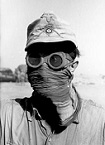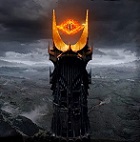Icier
Posts: 564
Joined: 7/15/2014
From: a sunny beach nsw
Status: offline

|
Finally again from Wikipedia is the number of Russian tank corps raised during the war..(remember that a corp is approx a German panzer div)
Eastern Front of World War II
Tank Corps were reformed in March 1942 on a smaller scale than the pre-war Tank Corps. At first they consisted of two Tank Brigades and a motorised rifle brigade, with some Corps elements such as reconnaissance, anti-tank, or pioneers added in. This made them essentially a division size formation with ca. 120 to 180 tanks. The formation was slightly weaker than a German Panzer division at this stage in the war. It was determined that this was too weak, and a third tank brigade was added to increase the offensive power. The final organisation as published in 1944 included an additional heavy tank or heavy self-propelled gun regiment, plus a medium and a light self-propelled gun regiment.
A total of 31 tank corps were formed during the war, with 12 of them earning the designation of a Guards Tank Corps. Due to the destruction of the 21st Tank Corps at the Second Battle of Kharkov and the use of some tank corps to form mechanised corps, no more than 24 of them actually saw combat.
The tank corps were the basic building block of the Tank Armies (see List of Soviet armies#Tank Armies).
Most tank corps were converted to Tank Divisions in 1945-6. See List of Soviet Army divisions 1989-91.
List of Tank Corps
1st Tank Corps
2nd Tank Corps
3rd Tank Corps – renamed 9th Guards Tank Corps after Battle of Radzymin (1944).
4th Tank Corps – March 42 – Feb 43 – converted to 5th Guards Tank Corps
5th Tank Corps – formed April 1942. Equipped largely with British-built Valentine tanks, 5 TC was badly handled in the early stages of the 1943 Smolensk operation, being mauled both from the air and from the ground. However the deflection of German units necessitated by the sacrifice of 5 TC meant that Spas Demensk fell on 13 August 1943.[1]
6th Tank Corps – see 11th Guards Tank Corps
7th Tank Corps
8th Tank Corps – Formed May 1942 in the Moscow Military District. Assigned to Western Front for virtually its entire career. After being nearly destroyed the brigades were reassigned and the Corps HQs used to form 3rd Mechanized Corps in September 1943.[2]
9th Tank Corps – the 9th Tank Division can trace its history back to 12 May 1942 when the 9th Tank Corps (ru:9-й танковый корпус (СССР)) was formed in the Moscow Military District.[3] It took part in the Battle of Kursk, then across Ukraine with the Central, Belorussian, and 1st Belorussian Fronts. It ended the war in Berlin. As part of the occupation forces, it was assigned to the 1st Guards Tank Army (also 1st Guards Mechanised Army). In 1957, it was reorganized into a Heavy Tank Division and re-designated the 13th Heavy Tank Division. This lasted until 1965, when it was returned to its original 9th Tank Division designation. This it retained until its withdrawal from the GDR in 1991 when it was disbanded. Its divisional headquarters was at Riesa.
10th Tank Corps (Soviet Union)
11th Tank Corps
12th Tank Corps
13th Tank Corps – began in April 1942 with 65th, 85th, and 88th Tank Brigades and 20th Motor Rifle(?) Brigade. In July 1942 brigades assigned were the 85th, 158th, and 167th Tank and 20th Motor Rifle(?) Brigade. It was "an oddball in the Soviet Army. 13th Tank Corps had been so shot up that most of its tank brigades were removed in September–October 1942, and when Mechanised Brigades were substituted at the beginning of November, it should have been redesignated as a Mechanised Corps with a new number, as had happened to other tank corps in similar situations. Instead, the corps retained the number '13' and even the Soviet sources get confused on what to call it: a tank corps or a mechanised corps. It had the subordinate units of a mechanised corps when it went into battle in late November and December 1942. It fought as a mechanised corps with 57th, 51st and 2nd Guards Armies during December in the mobile battles against German Panzers south of Stalingrad, and in recognition of its actions there on 9 January 1943 the 13th Mechanised Corps was redesignated as the 4th Guards Mechanised Corps."[4] See ru:13-й танковый корпус (СССР). Later 4th Guards Mechanised Division, and 4th Guards Motor Rifle Division.
14th Tank Corps
15th Tank Corps – fought in Battle of Grodno 1939 during Invasion of Poland. Became 7th Guards Tank Corps
16th Tank Corps – was part of 2nd Tank Army on formation. Became 12th Guards Tank Corps (1943) and 12th Guards Tank Division (1946).[5]
17th Tank Corps – became 4th Guards Tank Corps after Operation Little Saturn.
18th Tank Corps
19th Tank Corps
20th Tank Corps – the 20th Tank Division can trace its history back to 12 December 1942 when the 20th Tank Corps was formed in the Moscow Defense Zone. It took part in the counter-offensives in the winter of 1942/43 and the summer 1943 offensives in the southern Ukraine. After taking part in the offensives in 1944 and early 1945, it was in Stavke Reserves when the war ended. It was allocated to the Northern Group of Forces by Directive No. 11096, where it remained through the Cold War. In later 1945, it was reorganized into the 20th Tank Division. Between 1949 and 1955, it was known as the 7th Tank Division, although as a cadre unit. IN 1955, it was restored to full strength and renamed the 20th Tank Division. It would remain in southern Poland until 1991 when it was disbanded.
21st Tank Corps
22nd Tank Corps
23rd Tank Corps
24th Tank Corps (see also http://stalingrad.ic.ru/s22tcorp.html for 22nd Tank Corps)
25th Tank Corps – formed June 1942 in the Moscow Defence Zone. Originally formed previously as 25th Mechanised Corps in Kiev MD, 1941. Participated in the 'Liberation of Western Ukraine” and fought at Stalingrad, Kursk, Belgorod-Kharkov, Zhitimir-Berdichev, Rovno-Lutsk, Lvov, Vistula-Oder, Czestochowa, Berlin, Prague and other operations and actions.[5] Converted to 25th Tank Division after the end of the war. Postwar assignment to 4th Guards Mechanised Army in the 1940s and 1950s; Withdrawn From Group of Soviet Forces, Germany/ Western Group of Forces, 20th Guards Army. Regiments (formerly brigades) designated “Novogorod.” Deactivation site: Kiev MD.
26th Tank Corps
27th Tank Corps – formed in the Moscow Defense Zone. The 27th was never committed to combat, but instead on 8 September 1942 it was reorganized into the 1st Mechanised Corps.
28th Tank Corps
29th Tank Corps
30th Tank Corps[6]
31st Tank Corps – eventually became 31st Tank Division. Raised in the Moscow Military District, 1943. Associated with 1st Tank Army.[5] Participated in fighting at Kursk, Belgorod-Kharkov, Lvov-Sandomir, Carpathian-D.khmk,y, Sandomir bridgehead, Vistula-Oder, Prague and other operations and actions. Withdrawn From Central Group of Forces, Czechoslovakia. Eventually amalgamated with 47th Guards Tank Division at Mulino to become 3rd Motor Rifle Division after the fall of the Soviet Union.
Guards Tank Corps
1st Guards Tank Corps
2nd Guards Tank Corps
3rd Guards Tank Corps
4th Guards Tank Corps – now 4th Guards Tank Division
5th Guards Tank Corps
6th Guards Tank Corps – Raised in the Baltic MD, 1941, re-formed in Moscow MD, 1942. Formed as 12th Tank Corps and successively redesignated as 6th Guards Tank Corps (1943) and 6th Guards Tank Division (1946). Participated in fighting at Kursk,[citation needed] Omogozkk, Rmsosh, Warkov, Kmsncgrad, Kursk, Gel and other operations and actions. Past-war assignment to 3rd Guards Mechanized Army in the 1940s and 1950s. Honorifics and Awards included 'Kiev' “Berlin,”[citation needed] Orders of Lenin, Red Banner, Suvorov and Bogdan KJdem’nmku. Withdrawn from Group of Soviet Forces in Germany, 1st Guards Tank Army in 1982.
7th Guards Tank Corps – Withdrawn from Group of Soviet Forces in Germany Western Group of Forces, 1st Guards Tank Army.[5] Raised: Initially in L3elormswmMD, 1938; broken up and re-formed in Moscow MD, 1942. Initially designated as 15th Tank Corps, becoming successively the 7th Guards Tank Corps (1943) and 7th Guards Tank Division (1946). Participated in "Liberation of Western Ukraine" and fighting at Gstrogozhsk. Rm.msh, Kharkov, Kursk, Gel and other operations and actions. Postwar assignment to 3rd Guards Mechanised Army in the 1940s and 1950s. Honorifics and Awards: "Kiev." "Berlin," Order of Lenin, Twice Red Banner, Suvurov and Kummv. Deactivated in the Moscow MD.
8th Guards Tank Corps
9th Guards Tank Corps – 3rd Tank Corps was formed at Tula in the Moscow Military District. It took part in the winter counter-offensives in 1942/1943, the Battle of Kursk, then across Ukraine and then the summer offensive in 1944, Operation Bagration, with the Central, Belorussian, and 1st Belorussian Fronts. On 20 November 1944, after the Battle of Radzymin, it was awarded ‘Guards’ status and re-designated the 9th Guards Tank Corps.
10th Guards Tank Corps: ex 30th Tank Corps. Now 10th Guards Uralsko-Lvovskaya Tank Division.
11th Guards Tank Corps – The 11th Guards Tank Division can trace its history back to 10 April 1942 when the 6th Tank Corps was formed in the Moscow Defense Zone.[3] It took part in the Battle of Kursk, then across Ukraine with the Central, Belorussian, and 1st Belorussian Fronts. On 23 October 1943, it was awarded ‘Guards’ status and redesignated the 11th Guards Tank Corps. It ended the war in the Berlin area. As part of the occupation forces, it was reorganized as the 11th Guards Tank Division and assigned to the 1st Guards Tank Army (also called 1st Guards Mechanised Army during 1946–1957). For the occupation period and post-war era, it was mainly uneventful until 1968 when it took part in the invasion of Czechoslovakia. In 1992 it was withdrawn from Germany and landed in Slonim the newly independent Belarus. It would eventually be reorganized into the 11th Guards Mechanised Brigade. Division Headquarters was at Dresden in the 1980s.
12th Guards Tank Corps – former 16th Tank Corps. 16 TC was formed on 1 June 1942 in the Moscow Defense Zone. On 20 November 1944, it was awarded ‘Guards’ status and re-designated the 12th Guards Tank Corps. In later 1945, it was reorganized into the 12th Guards Tank Division.
If we go back & check AAR they all deal with the composition of the German forces on Eastern front,
none about the composition of the Russian army...so what you have is a Historical German army
facing a non historical Russian Army.
I know the arguments about conserving forces & I have no problems with it...BUT IF YOU TO FIELD
A NON HISTORICAL ARMY, THE SAME SHOULD APPLY TO THE GERMANS.
So, it comes back to what type of war you want to fight, I, for instance want to refight the actual
41-45 with the units fielded by both sides, while others would like to play "what if".
Lets just hope that the developers give us players both the options.

< Message edited by Ice -- 7/8/2016 10:42:06 PM >
|
 Printable Version
Printable Version

















 New Messages
New Messages No New Messages
No New Messages Hot Topic w/ New Messages
Hot Topic w/ New Messages Hot Topic w/o New Messages
Hot Topic w/o New Messages Locked w/ New Messages
Locked w/ New Messages Locked w/o New Messages
Locked w/o New Messages Post New Thread
Post New Thread